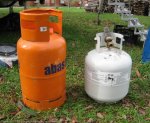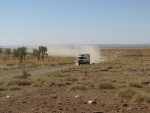in preparation for a trip through South America.
Here's some info on propane in expedition vehicles, with some specific info on South America:
http://www.hackneys.com/travel/docs/propane4xvehicles.pdf
While we were on the South America panel at OvEx 12, Rob Blackwell mentioned that he'd created additional LP/Propane info to supplement mine while they were in South America, but I don't know where he's got it. His web site is:
http://www.whiteacorn.com/
There are >1,500 waypoints for South America here, including places to refill Propane:
http://www.hackneys.com/travel/index-gpssawaypoints.htm
Propane is quick, easy, clean and it's great when you can easily find it. You can almost always find each country's portable LPG/LP/Propane portable tanks, at least in market towns, as most people use that for home cooking fuel. It can be much more challenging to impossible to refill a fixed tank in a specific country. Or, it can be done at a gas station, it varies depending on the country you are in.
Conversely, you can find diesel anywhere on the planet.
It's always best to have multiple ways to do the same thing, e.g. heat water, cook food, etc.
My goal was to build a 12/24VDC and diesel only vehicle, but due to the timeline, we ended up with propane.
We made it work in South America, but it wasn't always easy:
http://www.hackneys.com/travel/argentina/docs/thegasman.pdf
As Charlie mentioned, it is very important to build a storage compartment that will contain the bottles/cylinders that are local to the country you are in. Those bottles/cylinders are not the same size as the U.S. market and vary with each country.
Secondly, you'll need to carry a good kit of LP grade hose, fittings and adapters.
The easiest possible route for propane is to just use the bottles that are available in each country. Buy local fittings to connect to that country's bottle and adapt them onto your feed hose. The local connections are widely available.
Refilling a fixed tank can be problematic, so at a minimum, if you have a fixed tank, build your truck to accommodate a local portable tank, a two-way valve, and your fixed tank.
Using the engine cooling system + diesel for heat and hot water and propane only for cooking would be a very efficient path. Heating with propane goes through a lot of fuel.
Based on our experience, the single biggest reason to go to the trouble of rigging for propane is for an exterior grill. We used ours constantly and would struggle to give up that capability.
Chile vs. U.S. portable tank



